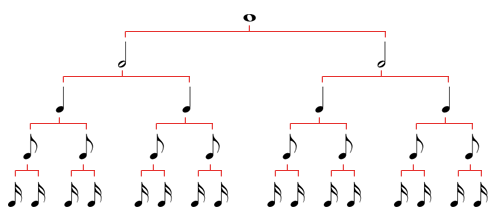Resources from the 2016 Twitter Math Camp Presentation
Slides from the presentation
Resources from the 2015 Global Math Department Presentation
Slides from the presentation
The book that I took my musical excerpts from
The recording of the presentation
Rhythm and Counting
1. Use rhythm to divide note values into fractional parts.
Then, add and subtract the note values. Let students hear the rhythms.
2. Play varying tempos (beats per minute) to demonstrate different speeds, ratios, slopes, etc. Here is the metronome I typically use, but Google has an Online Metronome too!
3. Play two or more meters, note values, or tempos at the same time (called a polyrhythm). You will be able to hear the conflicting ratio of the two meters, and you can use the idea of a least common multiple to determine when the two meters will line up. Here is an African Trance Polyrhythm Beat Generator.
Sound Waves and Sine Waves
4. Ask students to transform a sine function by changing the amplitude or period. Then, play the tones that correspond to those functions and let students notice the impact amplitude has on volume and period has on pitch and frequency. Here is an online tone generator.
5. Ask students to add two sine functions together, then let them hear the tones that correspond to the functions, first separately, then as a composite function. For example, noise canceling headphones work by taking the sine waves produced by the environment and adding the corresponding opposite function to produce a zero function. Complex tones, such as that of a guitar, are built from the addition of many sine functions, all with different frequencies and amplitudes.
6. Use a Fast Fornier Transform (FFT) to decompose complex periodic functions into their component sine waves. Let students experiment to see what sounds produce different component functions. Here is a free online FFT and instrument tuner program, however it's partially in Japanese. If you dig I bet you can find a free app in English...
7. Ask students to order various rational numbers on the number line. Then, play them the corresponding intervals and ask them to order them from the smallest interval to the largest interval. Allow students to compare their results.
8. Have students build a musical scale by multiplying various intervals together. Let them listen to the scale they created by playing the corresponding tones.
9. Have students physically build pipe instruments by taking the ratios used to build the scale and cut pipes to length. Here is one option that uses hard PVC pipe. I suggest getting plastic golf club holders and cutting them to length, similar to these BoomWhackers.
10. Have students investigate the reasons why the first pianos were tuned using a rational intervals (also called Just Intonation), and why we currently tune pianos using a irrational intervals (also called Equal Temperament). More information here.
11. Introduce three musical transformations that composers use to create melodies: transposition, inversion, and retrograde. Play examples of each one of these transformations. Then, have them experiment with compositions to develop "rules" or "theorems" about how they work.
12. Allow students to create their own compositions using the transformations.
13. Push students to investigate these musical transformations further by verifying the existence of inverse operations, the commutative property, closure, and more.






Wow. You presented a wealth of resources here. Thanks.
ReplyDeleteThis is a fascinating read! The connection between mathematics and music in the classroom is often overlooked, yet both subjects rely heavily on patterns, rhythm, and logical structures. Integrating music into math lessons can make learning more enjoyable and improve students’ ability to understand complex concepts. I’ve seen students become more confident in problem-solving when creative teaching methods are used alongside traditional approaches. For anyone struggling with concepts outside the classroom, seeking math assignment help can also be a great way to reinforce learning and build stronger math skills. Great article—thanks for sharing!
ReplyDelete